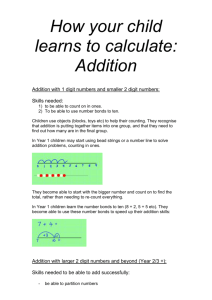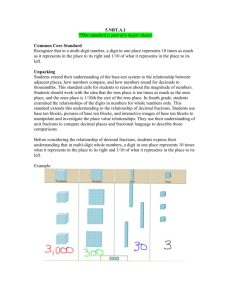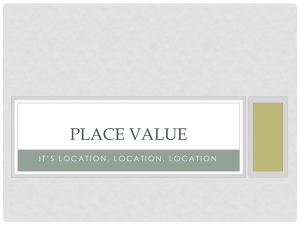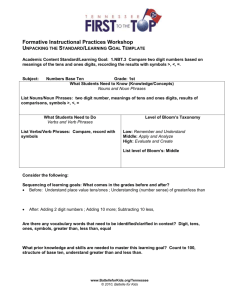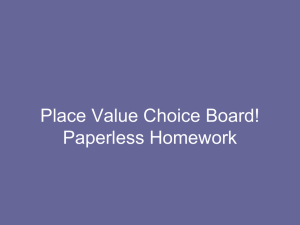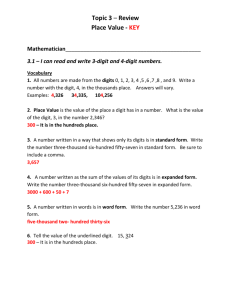3rd Grade Chapter 1
advertisement
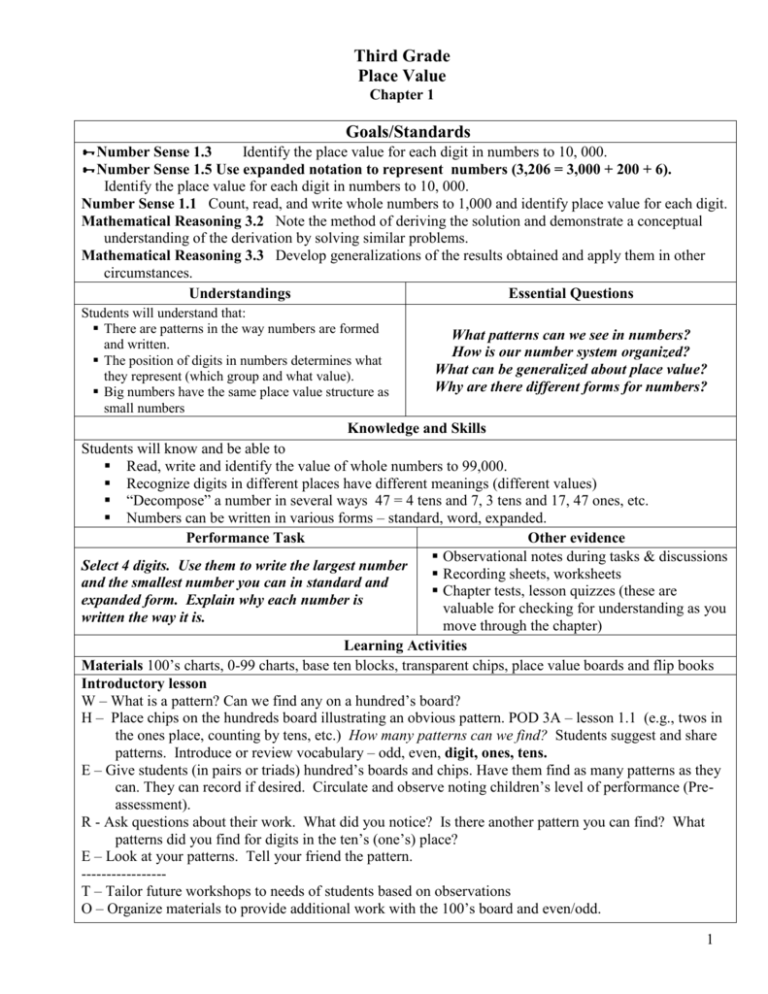
Third Grade Place Value Chapter 1 Goals/Standards Number Sense 1.3 Identify the place value for each digit in numbers to 10, 000. Number Sense 1.5 Use expanded notation to represent numbers (3,206 = 3,000 + 200 + 6). Identify the place value for each digit in numbers to 10, 000. Number Sense 1.1 Count, read, and write whole numbers to 1,000 and identify place value for each digit. Mathematical Reasoning 3.2 Note the method of deriving the solution and demonstrate a conceptual understanding of the derivation by solving similar problems. Mathematical Reasoning 3.3 Develop generalizations of the results obtained and apply them in other circumstances. Understandings Essential Questions Students will understand that: There are patterns in the way numbers are formed and written. The position of digits in numbers determines what they represent (which group and what value). Big numbers have the same place value structure as small numbers What patterns can we see in numbers? How is our number system organized? What can be generalized about place value? Why are there different forms for numbers? Knowledge and Skills Students will know and be able to Read, write and identify the value of whole numbers to 99,000. Recognize digits in different places have different meanings (different values) “Decompose” a number in several ways 47 = 4 tens and 7, 3 tens and 17, 47 ones, etc. Numbers can be written in various forms – standard, word, expanded. Performance Task Other evidence Observational notes during tasks & discussions Select 4 digits. Use them to write the largest number Recording sheets, worksheets and the smallest number you can in standard and Chapter tests, lesson quizzes (these are expanded form. Explain why each number is valuable for checking for understanding as you written the way it is. move through the chapter) Learning Activities Materials 100’s charts, 0-99 charts, base ten blocks, transparent chips, place value boards and flip books Introductory lesson W – What is a pattern? Can we find any on a hundred’s board? H – Place chips on the hundreds board illustrating an obvious pattern. POD 3A – lesson 1.1 (e.g., twos in the ones place, counting by tens, etc.) How many patterns can we find? Students suggest and share patterns. Introduce or review vocabulary – odd, even, digit, ones, tens. E – Give students (in pairs or triads) hundred’s boards and chips. Have them find as many patterns as they can. They can record if desired. Circulate and observe noting children’s level of performance (Preassessment). R - Ask questions about their work. What did you notice? Is there another pattern you can find? What patterns did you find for digits in the ten’s (one’s) place? E – Look at your patterns. Tell your friend the pattern. ----------------T – Tailor future workshops to needs of students based on observations O – Organize materials to provide additional work with the 100’s board and even/odd. 1 Third Grade Place Value Chapter 1 Harcourt Resources Vocabulary – even, odd, digit, place value, expanded form, standard form, word form, number, numeral Number of the Day (NOD) 6A, 10A, 12A Problem of the Day (POD) 2A, 4A, 10A, 12A E-Lab – Number Patterns, Understanding 1,000 Family Involvement Activities – FA 1Activities and Games for Home or School - My Word Against Yours (5) Chapter Lessons – Suggested whole group activities 1. POD (2A) Expanded to investigate additional patterns 2. Lesson 1.1 Expanded to include digits, ones, tens (place value) as well ad even/odd/ 3. ATS (4B) Extend to place digits in different places. Compare the models for each number. Write each in standard, expanded and word form. 4. ATS (6B) This can be introduced using an overhead or individual white boards. 5. ATS (8) Use base 10 blocks or 1,000 books. 6. Lesson 1.5 with 100’s board displayed. Chapter 1 Lessons – Suggested small group guided instruction 1. Specific lessons with Guided Instruction based on the needs of the students. These can be used to introduce, instruct, review and/or assess students. Not all students would participate in all lessons. 2. Workbook and/or practice pages to familiarize students with the format. Their value lies in the discussion by students of their thinking. 3. Any of the activities to be used independently. The explicit instruction for the activity (unless exploration) usually needs to take place in a small group to assure understanding unless introduced and practiced in the whole group.. Chapter 1 Lessons – Suggested small group or partner activities. These can be prepared in advance and be used repeatedly throughout the unit once they have been introduced. The same activity can be repeated using a variety of materials or formats to insure flexibility in thinking and application, as well as providing novelty for continued engagement with the concept/task. Practice Game –High Number (xxviG) Advanced Learners (xxviF) Good to integrate place value with addition/subtraction practice. ELL (2B) Practice with even and odd numbers. POD (2A) E-Lab Number Patterns (2B) Challenge 1.1 (3) Practice with even and odd numbers. ATS(6B) Identify place value in numbers to 10,000. Early Finishers (6B) Place value riddles. E-Lab (6B) Understanding 1,000. Thinker’s Corner (9) - Extend this by having student write the numbers in varied forms, comparing or ordering the numbers.. 10. Challenge 1.4 (11) Copy onto card stock and make a matching activity or concentration game. 11. Challenge 1.5 (13) Complete as a small group or partner activity. 1. 2. 3. 4. 5. 6. 7. 8. 9. 2 Third Grade Place Value Chapter 1 Additional Resources Literature – The Kings Commissioners by Aileen Friedman, How Much is a Million by David Schwartz Instructional Resources 1. Math Centers:Take it to Your Seat – Place Value Puzzles 2. A Collection of Math Lessons -- Place Value Game (167) 3. Math Strategies You can Count on - Place Value Participation (94-95). 4. Teaching Student Centered Mathematics 3-5 – Activities 2.8 – 2.15 (47-52) What Comes Next? (48) This is a visual representation of very large numbers – 10,000 – 1,000,000. 5. Elementary and Middle School Mathematics:Teaching Developmentally – Chap 12. 6. Helping Children Learn Mathematics – Chapter 8 Hitting Hundreds – a calculator activity The Power of 10 on the Thousand Chart Activities 1. Place Value Roll (Spin or Draw) Use dice, spinners or cards to generate digits. Students can either determine in advance whether the goal is the largest or smallest number or they can do it at the end to determine a winner. Students can record their numbers in varied forms. 2. Matching/sorting cards. Can sort for a digit in a specific place, match different forms of the same number. 3. Base Ten Riddles: (Can be a matching game also). I have 2 ones, 6 thousands, and 4 tens. Who am I I have 3 ones, 7 tens, 4 hundreds, 9 thousands. Who am I? I have 17 ones I’m between 40 and 50. Who am I? Notes 3

